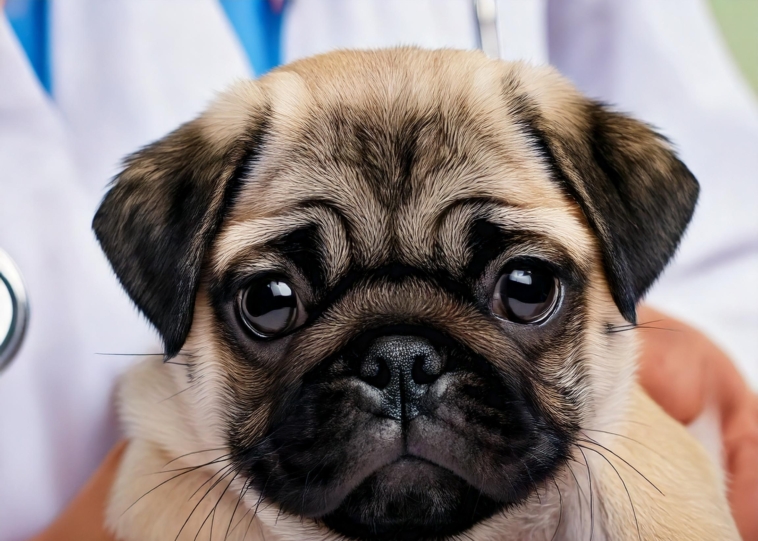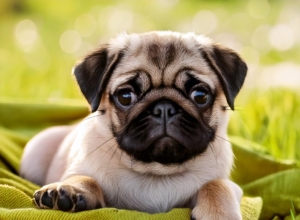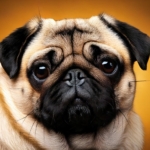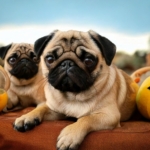So You Got a Pug Puppy: Welcome to the Wrinkle Squad
Pug puppies: living, snorting proof that squishiness is a lifestyle. With faces like crumpled velvet and personalities larger than their little, snoring bodies, they’re equal parts diva and cuddlebug. And if you’re lucky enough to own one, buckle up — this ride includes zoomies, snorts, and endless attempts to eat things that aren’t food.
Basic Bio: The Pug Puppy Rundown
- Origin: Ancient China (yes, they have royal bloodline — act accordingly).
- Size: 14–18 pounds of raw attitude and squish.
- Lifespan: 12–15 years of being led to the bathroom.
- Signature Look: Large eyes, bigger head, and a face that looks like it has lost a battle to a napkin.
Prepping the Palace: Your Home, Now Pug-Proofed
Think about your house as a toddler zone… but more snorty and less bouncy.
- Remove Hazards: Cords, poisonous plants, and anything chewable-looking must go. If it can be put in their mouth, they will chew it.
- Close Off Hazard Areas: Lock off hazard zones using pet gates so your pug can’t attempt Everest (a.k.a., the stairs).
- Create the Fundamentals: Food and water bowls, and a throne (bed) for the king (or queen).
- Play Area: Non-shred toys — pugs are emotional, but destructive boredom.
- Baby Gates: Because your pug is half-escape artist/half-furniture inspector.
- Temperature Control: Pugs overheat when you think of summer. Keep it cool, literally.
- Clean Floors: That mysterious crumb that has been lingering since last week? Your pug will find it. And eat it. Vacuum regularly.
Understanding Your Pug’s Weird (But Adorable) Behavior
These puppies are bundles of zoomies, cuddles, and mild chaos.
- Energy Levels: Short bursts of “wild raccoon” followed by three-hour naps.
- Social Butterballs: They love people, other dogs, and probably your neighbor’s cat.
- Training: They’re smart. when they feel like it. You’ll be impressed, then humbled.
- Barking & Whining: Expect commentary on everything.
- Cuddling: Prepare for sneak attacks of affection. They’ll glue themselves to your leg.
- Mouthing: Everything is a chew toy. Including you. Especially you.
Feeding Your Puglet: Michelin-Star Mealtime
Because every meal is an event when you’re raising a pug.
What They Need:
- Fat: Yes, for energy, but no to becoming a stuffed potato.
- Carbs: Moderately, but meat and fats need to be the VIPS.
- Vitamins/Minerals: Bones, teeth, immune system — they need the whole shebang.
Feeding Schedule:
- 0–3 months: Four small meals a day
- 3–6 months: Cut it back to three
- 6–12 months: Twice daily (with snacks… because they will treat you like you did forget them)
- No table scraps. No mystery snacks. And certainly no midnight fridge runs.
Vet Visits and Health 101: Keeping the Wrinkle Bean Happy
- Check-ups: Start early — 6–8 weeks — and then on a regular schedule.
- Deworming: Fleas, ticks, and worms — basically nature’s unwanted party crashers.
- Dental Care: Chew toys and brushing, unless you like pug breath strong enough to strip paint.
Training: Because Wild Pug Energy Needs Direction
- Positive Reinforcement: Treats, praise, and high-fives (if they had thumbs).
- Short Sessions: 5-10 minutes maximum. Their attention span is shorter than a sneeze.
- Crate Training: Make it cozy. Never use it as the “bad dog box.”
Social Butterfly Bootcamp
If you want a pug with confidence that doesn’t shriek at the mailman, socialize early.
- Early Start: Before they turn into tiny barky introverts.
- Keep it Positive: New people = good things (like treats or belly rubs).
- Puppy Playdates: Preferably with dogs who won’t be insulted by snorts.
- Explore the World: Grass, sidewalks, the pet store… even the vet’s office (boo).
- Watch the Vibes: Body language says it all. If the tail’s down, slow down.
Exercise & Play: Pug Zoomies in Action
They do enjoy playing… just not for extended periods.
- Play Bursts: Toddler energy. Play vigorously, nap more vigorously.
- Toys: Puzzle toys, squeaky toys, and chew toys that won’t disintegrate.
- Training Games: Snuggle learning into play. They won’t even realize they’re working.
Be warned: too much physical exercise = pug puddle. Hydrate and rest often.
Grooming: Spa Day, Every Day (Okay, Maybe Weekly)
- Wrinkle Wipes: Need to be washed daily. That fold keeps more than secrets.
- Nail Trims: Every two weeks or when you hear click-clack on the floor.
- Ear Cleaning: Weekly, or risk stink that would clear a room.
Common Pug Problems: Know Before You Snort
- Hip Dysplasia: Their joints can be drama queens, too.
- Dry Eye: They might appear sad… because they actually are.
- Corneal Ulcers: Large eyes, large risk. No roughhousing near the face.
Safety Tips:
- No Collars: Use a harness. Their throats are as delicate as their egos.
- Avoid Heights: They aren’t flying animals.
- Choking Hazards: If it is small and chewable, it is a hazard.
Building a Bond: From “New Roommate” to BFF
Pug love doesn’t occur overnight — it is forged in snorts, snacks, and unlimited patience.
- Quality Time: Play, snuggle, repeat.
- Rewards for Manners: When they sit instead of jumping? That deserves a treat.
- Training = Bonding: Communication builds trust — and less mess.
- Cuddle Up: Pugs run on affection.
- Slow Introductions: New pets and people need to be put through the “Pug Drama Meter.”
Final Snort: Living with a Pug Puppy
Caring for a pug puppy is kind of like parenting a toddler who snores and has an obsession with your socks. With the right prep, a sense of humor, and a steady supply of treats, you’ll raise a happy, healthy pug who’s equal parts snuggle monster and comic relief.
Just don’t forget: they’re not just dogs they’re royalty wrapped in wrinkles.





